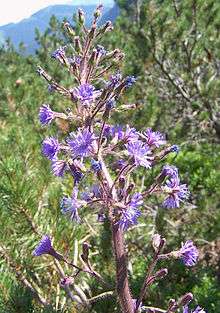Cicerbita
Cicerbita is a genus of flowering plants in the aster family, Asteraceae, native to Asia and Europe.[1][2] They are known commonly as blue sow thistles.[3] The word Cicerbita is from the Italian, meaning "chickory-like", a comparison to Cichorium, the chicory genus.[4]
| Cicerbita | |
|---|---|
 | |
| Cicerbita alpina | |
| Scientific classification | |
| Kingdom: | Plantae |
| Clade: | Tracheophytes |
| Clade: | Angiosperms |
| Clade: | Eudicots |
| Clade: | Asterids |
| Order: | Asterales |
| Family: | Asteraceae |
| Subfamily: | Cichorioideae |
| Tribe: | Cichorieae |
| Subtribe: | Lactucinae |
| Genus: | Cicerbita Wallr. |
Description
Cicerbita are usually perennial plants, often with rhizomes.[5] Annual species are also known.[6] The leaves are undivided or pinnate. The flower head has 5 to 30 florets in shades of blue or purple, or occasionally white[5] or yellow.[6] The achene is ribbed and has a pappus of bristles and hairs.[5]
Systematics
The plants of this genus were included in genus Lactuca, the lettuces, until 1822,[7] when the first of them were separated based on the morphology of the fruits.[6] The definition of the genus is still in debate and very unclear.
- Accepted species[8]
- Cicerbita canadensis (L.) Farw. – eastern and central parts of Canada and USA
- Cicerbita chiangdaoensis H.Koyama – Thailand
- Cicerbita gmelini Beauverd – Altay Republic
- Cicerbita nepalensis Kitag. – Nepal
- Cicerbita nuristanica Kitam. – Afghanistan
- Cicerbita oligolepis Chang ex C.Shih – Yunnan
- Cicerbita thianschanica (Regel & Schmalh.) Beauverd – Altay Republic, Kazakhstan, Kyrgyzstan, Tajikistan, Uzbekistan, Xinjiang
- Cicerbita unicostata Kitam. – Afghanistan
- Cicerbita violaefolia (Decne.) Beauverd – western Himalayas
- Cicerbita zeravschanica Popov ex Kovalevsk. – Kyrgyzstan, Tajikistan, Uzbekistan
Uses
Cicerbita alpina is eaten as a vegetable in Italy, part of its native range. The young shoots are boiled and served in olive oil or tomato sauce. They are considered a delicacy and can be had in restaurants.[9] The shoots in oil can be purchased in markets under the local name insalata dell'orso ("bear salad").[4] The plant is collected from the wild and there is some concern that it may be threatened with overexploitation, so local ordinances now limit wild collection in some areas. Field trials are underway to examine the possibility of cultivating the plant in agriculture.[9]
References
- Wallroth, Carl Friedrich Wilhelm. 1823. Schedulae Criticae de Plantis Florae Halensis Selectis. Corollarium novum ad C. Sprengelii Floram halensem. Accedunt generum quorundam specierumque omnium definitiones novae, excursus in stirpes difficiliores. Tom. I. Phanerogamia 1: 433
- Tropicos, Cicerbita Wallr.
- Genus Cicerbita Wallr. Archived 2012-09-21 at the Wayback Machine Germplasm Resources Information Network (GRIN).
- Scartezzini, F., et al. (2012). Domestication of alpine blue-sow-thistle (Cicerbita alpina (L.) Wallr.): six year trial results. Genetic Resources and Crop Evolution 59(3) 465-71.
- Cicerbita. Flora of China.
- Bano, R. and M. Qaiser. (2010). The genus Cicerbita Wallr. (Cichoriae-Asteraceae) in Pakistan and Kashmir. Pakistan Journal of Botany 42, 35-56.
- Chu, S. (1991). On circumscription of the genus Cicerbita Wall., and two new genera of Compositae from Sino-Himalayan Region. Archived 2014-11-26 at the Wayback Machine Acta Phytotaxonomica Sinica 29(5) 394-417.
- Flann, C (ed) 2009+ Global Compositae Checklist
- Scartezzini, F., et al. Domestication and field management trials of Cicerbita alpina (L.) Wallr. In: First International Conference on Crop Wild Relative Conservation and Use. September 14–17, 2005. Agrigento, Sicily, Italy. pg. 14-17.